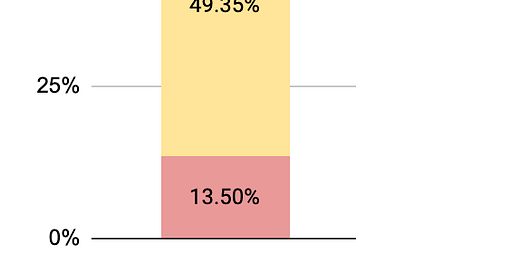We spend a lot of time in this newsletter talking about how many locations are at or above certain arbitrary throughput (“speed”) thresholds like 25 download/3 upload, or 100 download/20 upload. As I’ve done before, I think it’s helpful to occasionally step back and zoom out. What we see is a country is covered in cable broadband. More than 86% of the country has access to at least one cable or fiber broadband service according to the FCC maps.
The chart above is the number of cable or fiber-to-the-home broadband offerings at any location in the 50 states plus D.C.. Only 5% of locations have access to three or more cable or fiber (I’ll call them wired) ISPs. Thirty-two percent of locations have access to two wired offerings. And 49% have access to only one wired offering.
Importantly, 13.5% of locations have access to zero wired offerings. That’s 14 million locations nationally without a cable or fiber ISPs that serves their location. This number is slightly different from the Unserved and Underserved locations that will be eligible for funding in the NTIA’s BEAD program. According to the recently released 2nd version of the FCC National Broadband Map, 11.9 million locations are Unserved or Underserved. That means there are 3 million locations that are Served by broadband according the official definition, and ineligible for BEAD grants, but do not have a cable or fiber ISP. Those are locations that are Served by DSL at 100 Mbps download and 20 Mbps upload, or Licensed fixed wireless or Licensed-by-rule fixed wireless at the same throughputs.
Generally, cable and fiber ISPs provide service at 100 Mbps download, 20 Mbps upload or better according to their FCC filings. In fact, over 99% of the locations served by wired ISPs meet that threshold. That’s not the case for other technologies. 58% of DSL filings are Unserved, and only 8% of DSL filings are Served. With both licensed fixed wireless and unlicensed fixed wireless, there is a mix of Unserved, Underserved, and Served filings.
It’s an unpopular opinion in my demographic, but I think the cable and fiber ISP filings are probably generally representative and fair at this point. After a full round of challenges, I think we’d know about serious over-reporting of coverage. And I believe most cable ISPs can provide 100 Mbps download and 20 Mbps upload to the router, despite what speed tests may say. In fact, according to a new Ookla report, in the U.S. Wifi speeds are 42% of ethernet speeds, due largely to older Wifi technology in routers and access points.
Below is how many Unserved and Underserved each state would have if we only counted cable and fiber ISPs. Pennsylvania, for example, would have 357,881 Unserved and Underserved locations, an increase from 333,000 Unserved and Underserved according the BEAD definition. Thus, any estimate of the truly Unserved above 358,000 is claiming that cable ISPs either don’t have the coverage they’re reporting, or don’t provide the service they’re reporting.
I’ve long argued that in many states there is enough money to reach all the Unserved and Underserved with fiber-to-the-home. One way we could fail to reach that goal is if we spend much more per location than we need to. Another way to is to include locations in grant programs that don’t legitimately need broadband upgrades. The money is limited, let’s choose only the locations that most need the upgrades.






I agree. The Unserved and Underserved locations generally are where you only have the option of DSL service, a fixed wireless service that is using low-band spectrum, or satellite. If a cable operator is providing service in an area, it is almost certainly "Served". Almost all cable operators have deployed a minimum of DOCSIS 3.0 in their cable plant, which can easily support speeds over 100 x 20 Mbps. In fact, many have deployed DOCSIS 3.1 and can provide gigabit download speeds, and larger providers are now moving to DOCSIS 4.0 so they can support multi-gigabit download and uploads. One of the managed services we provide is provisioning of the CPE for cable operators, and a lot of our cable operator customers actually have us provision the speed on devices higher than the advertised speed so their subscribers will have a better experience.